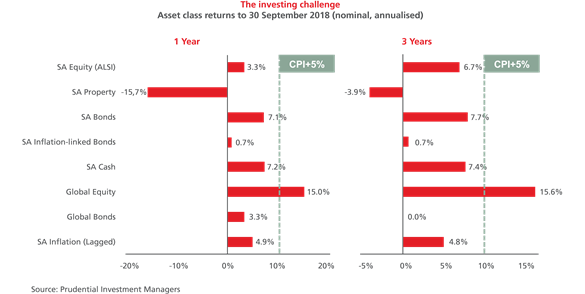Coping with the challenges of a lower-return world
For the last few years, South African investors have been faced with the scary reality of lower returns from most asset classes, which may have left them with a shortfall in the returns they need to live comfortably in retirement. So what steps can investors take to help them cope with this problem of unusually long investment underperformance? This article suggests some solutions to mitigate the challenges presented by today’s lower-return world.
The problem
These days, a generally accepted return target required to accumulate enough retirement savings over time is CPI+7% p.a. This level would be typical of a high-equity (“balanced”) fund, and means that your returns should beat inflation by 7% per year on average in order to avoid being eroded by inflation, while also growing your capital enough to last 30 years or more in retirement. Of course, due to financial market ups and downs investment returns will vary from year to year, but investment managers like Prudential offer unit trusts designed to meet this specific target over the medium-term that take market volatility into account.
For some time now local asset returns – especially equities – have been disappointingly low. This is due to a combination of many factors, both global and local. The graph below provides a snapshot of the low returns investors have received over the last one- and three-year periods. Only one asset class – global equity – has delivered a performance above CPI+5% p.a. (but global equity exposure is limited to only 40% of a retirement portfolio in South Africa). Over three years even SA equity and listed property, riskier assets that theoretically offer investors higher rewards for the higher risk involved, have not met this target, and their one-year performance is even weaker.

Some solutions pre-retirement
So what can investors do to help ensure they get the returns they need and lessen the impact of an extended period of poor asset class performance? Here are five techniques for retirement planning that can help reduce the risks for your retirement portfolio.
- Build a well-diversified portfolio with enough growth assets (equities, listed property) to meet your retirement goal, while also including some income assets (bonds, cash) to cushion the market downturns. Such diversification can reduce both the volatility of returns and the severity of negative return periods, without meaningfully impacting the total returns you earn. Balanced funds (represented in ASISA’s multi-asset high-equity category) can have up to 75% equity exposure, which we believe is necessary to produce the typical CPI+7% return expected from them over time.
- Don’t be too conservative as you approach retirement, or even after you retire. If you switch to a lower return target like CPI+2% (typical of an Income fund, for example), an option suggested by some, you may experience less volatility but you are more likely to end up running out of money in retirement. This is because people generally accumulate the vast majority of their retirement savings afterthey’ve retired (over 80%), due to the compounding effect of returns over time. Based on our analysis using actual experience, if you stay invested in a CPI+5% unit trust throughout your career and retirement, your funds will last 11 years longer than if you had switched to a CPI+2% strategy at retirement at age 60.
Better yet, consider sticking with a more risky CPI+7% p.a. target for your retirement funds for your entire life. You will need to tolerate higher volatility over the years, but the risk of running out of money in retirement will be much lower. An experienced financial adviser can help you weather the short-term market storms.
- Use an active investment manager. Active management is very important because the manager can underweight assets when they are overvalued in order to mitigate future losses in market downturns, while also overweighting assets when they are cheap.
- Also proven to help is a valuation-based approach to both stock selection and asset allocation: historic performance data show that buying assets at undervalued (cheap) levels increases the probability of enhanced future returns, while at the same time reducing the probability of losses in market downturns.
- Choose unit trusts that are purposefully managed to help compensate for market downturns, using a risk-conscious approach to meet a longer-term return objective like retirement over time. In the Prudential fund range this includes the Prudential Balanced Fund.
Post-retirement solutions
If you’re already in retirement and drawing an income, consider the following approaches.
- Don’t panic when returns don’t meet your expectations. Remember that financial markets move in cycles and that history has shown that performance will eventually rebound. Instead, speak to your financial adviser, who can help you find ways to manage your budget and investments in difficult times.
- Although your initial instinct may be to switch more of your portfolio to conservative assets like bonds or cash, resist this impulse. Selling equities in a downturn will simply lock in your losses. Your financial adviser may actually find you need to diversify further, or take on more exposure to growth assets. Wait for them to apply some analysis to your situation.
- If your retirement portfolio is targeting a CPI+5% p.a. return over time, for example, try to draw a regular income level of less than 5% of your total portfolio every year – say, 4% – so that your drawdown is less than what you’re earning. This will allow your capital to continue growing at a rate above inflation and, in theory, you should never run out of funds.
- In periods of above-average returns, don’t be tempted to spend the extra cash right away. Instead, save it for the underperforming times.
While using these approaches may not be appropriate for everyone, some may find that they do go some way towards mitigating the risks associated with the current period of investment underperformance, while also lowering the chances that an investor will run short of money in retirement.
Do you need more information on retirement investing? Speak to your Financial Adviser or contact our Client Services Team at 0860 705 775 or email query@prudential.co.za.
Share
Did you enjoy this article?
 South Africa
South Africa Namibia
Namibia




 Get the Newsletter
Get the Newsletter